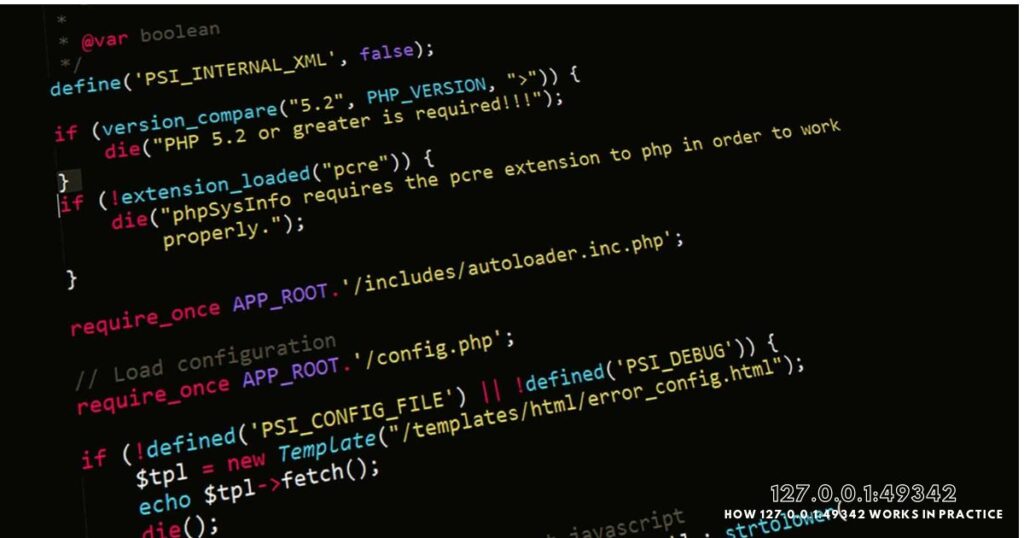In the world of software development, you’ve likely encountered the cryptic address “127.0.0.1:49342” at some point. But what does this string of numbers and dots really mean?
Let’s dive deep into the realm of localhost and port numbers to unravel this mystery and explore why it’s so crucial for developers.
What is 127.0.0.1?
The Localhost Address
The IP address “127.0.0.1” is known as the localhost address, a special address that refers to the local computer or device that is being used.
It’s part of a larger range of IP addresses reserved for loopback purposes, allowing your machine to communicate with itself. This seemingly simple concept is the backbone of local development and testing.
Importance of Localhost
Localhost plays a pivotal role in the software development lifecycle:
- Testing Environment: It provides a safe, isolated space to test applications without affecting live servers or requiring an internet connection.
- Rapid Development: Developers can quickly iterate and debug without the lag of deploying to external servers.
- Security: Local testing minimizes exposure to external threats during the development phase.
“Localhost is like a sandbox for developers – a place to build, break, and rebuild without consequences.” – Anonymous Developer
What are Port Numbers?

Understanding Ports
Think of ports as virtual doors on your computer. Each door (port) leads to a specific service or application. When data arrives at your IP address, the port number tells it which door to go through.
Ports are categorized into three ranges:
| Port Range | Category | Description |
| 0-1023 | Well-Known Ports | Reserved for standard services (e.g., HTTP on 80, HTTPS on 443) |
| 1024-49151 | Registered Ports | Can be registered by companies for specific applications |
| 49152-65535 | Dynamic/Private Ports | Used for temporary connections |
The Role of Port 49342
Port 49342 falls into the dynamic/private port range. Operating systems often assign these ports automatically when an application needs one. It’s like a temporary parking spot for your application to receive and send data.
How 127.0.0.1:49342 Works in Practice

Running a Local Server
When you start a local development server, it typically binds to the localhost address and a specific port. Here’s a simple example using Python:
- On Windows: netstat -aon | findstr :49342
- On macOS/Linux: lsof -i :49342
This script creates a basic HTTP server on localhost, using port 49342. You can access it by opening a web browser and navigating to http://127.0.0.1:49342.
Use Cases for Local Development
Localhost is the unsung hero in various development scenarios:
- Web Development: Test your latest frontend changes without pushing to a staging server.
- API Development: Debug and refine API endpoints before exposing them to the world.
- Database Management: Configure and test database connections in a controlled environment.
Security Implications of Using Localhost
Security Benefits
- Isolation: Traffic to and from localhost doesn’t leave your machine, providing a natural barrier against external threats.
- Controlled Environment: You have full control over the testing environment, reducing variables that could impact security testing.
Security Risks
While localhost is generally secure, there are some considerations:
- Misconfiguration: Accidentally binding to a public IP instead of localhost can expose your development server to the internet.
- Local Malware: Malicious software on your machine could potentially access localhost services.
Troubleshooting Issues with 127.0.0.1:49342
1. Port Already in Use
If you encounter a “Port already in use” error, another application might be hogging your desired port. Here’s how to investigate:
2. Connection Refused
A “Connection refused” error often means the server isn’t running or is configured incorrectly. Double-check your server setup and ensure it’s actually listening on the specified port.
3. Firewall Restrictions
Sometimes, overzealous firewalls can block localhost connections. Review your firewall settings and add exceptions for your development environment if necessary.
Case Study: The Impact of Localhost on Development Speed
A team of developers at TechCorp was struggling with slow iteration cycles. Every change required a deployment to a staging server, taking up to 15 minutes each time.
By switching to a localhost-based development workflow, they reduced their iteration time to under 30 seconds. This 30x improvement in speed led to a 50% increase in feature output over the next quarter.
Conclusion
Understanding the intricacies of 127.0.0.1:49342 and localhost is crucial for any developer looking to streamline their workflow and create robust, secure applications. From rapid prototyping to thorough testing, localhost provides a powerful environment for bringing your ideas to life.
As you continue your development journey, remember that localhost is more than just an address – it’s your personal laboratory for innovation. Embrace it, master it, and watch your productivity soar.
FAQs
What is the meaning of 127.0.0.1 port?
The 127.0.0.1 part is the localhost IP address, while the port number (e.g., 49342) specifies which service on the localhost to connect to.
What are port numbers and their significance?
Port numbers are virtual endpoints that allow multiple network services to operate on a single IP address. They route incoming data to the correct application or service.
How do I connect to 127.0.0.1 localhost? Y
ou can connect to localhost by entering “127.0.0.1” or “localhost” in your web browser, followed by a colon and the port number if needed
What is a port address? What do you mean by well-defined port numbers?
A port address is a specific endpoint on a host, identified by a number. Well-defined port numbers (0-1023) are reserved for standard services, like HTTP (80) or HTTPS (443).
By demystifying 127.0.0.1:49342 and exploring the world of localhost, we’ve unlocked a powerful tool in the developer’s arsenal. Whether you’re building the next big web app or fine-tuning a complex API, understanding localhost is your key to faster, more efficient development. So the next time you see that familiar string of numbers, you’ll know exactly what’s going on behind the scenes.
More Post:

Mia Hazel is a finance expert and the author behind insightful content that simplifies complex financial concepts. With a passion for empowering readers to make informed financial decisions, Mia breaks down everything from budgeting to investments with clarity and precision.
Her work is dedicated to helping individuals navigate the financial world with confidence and achieve their financial goals. Follow her for practical tips and advice on all things finance.

